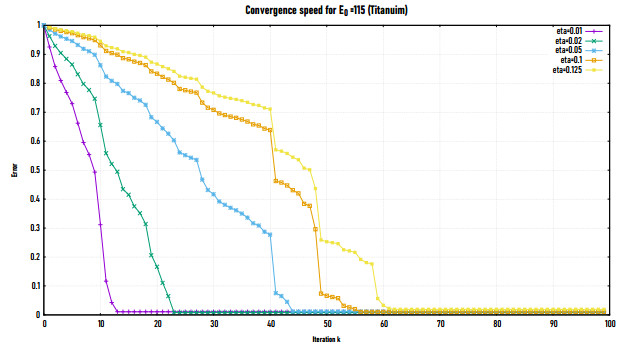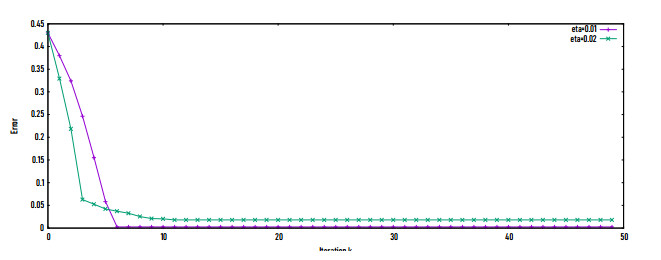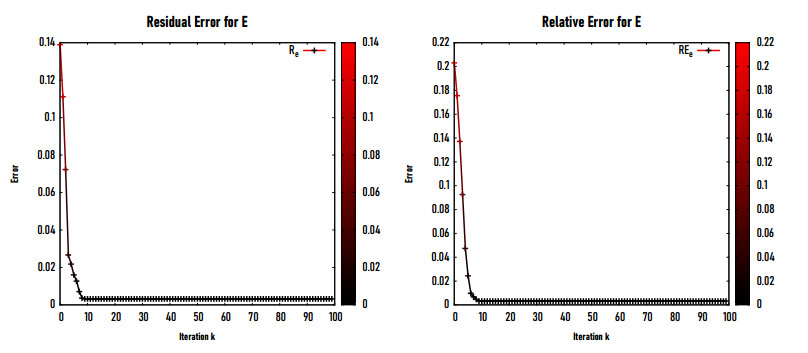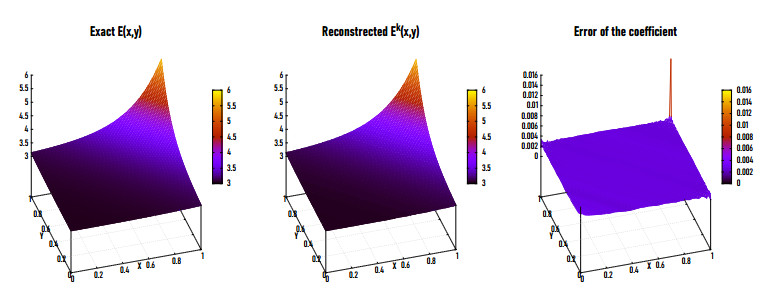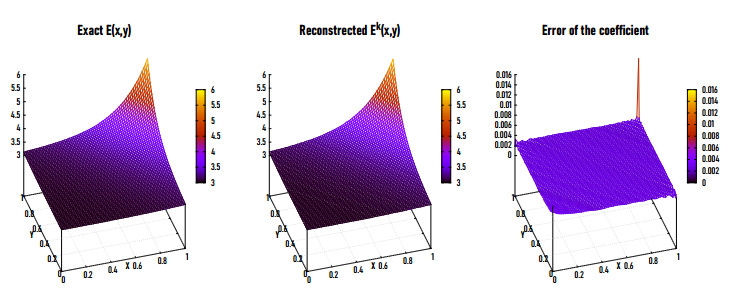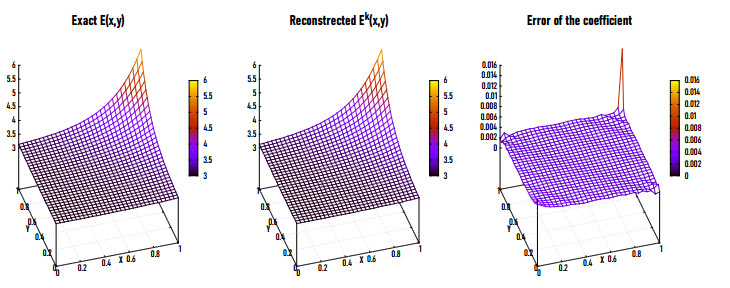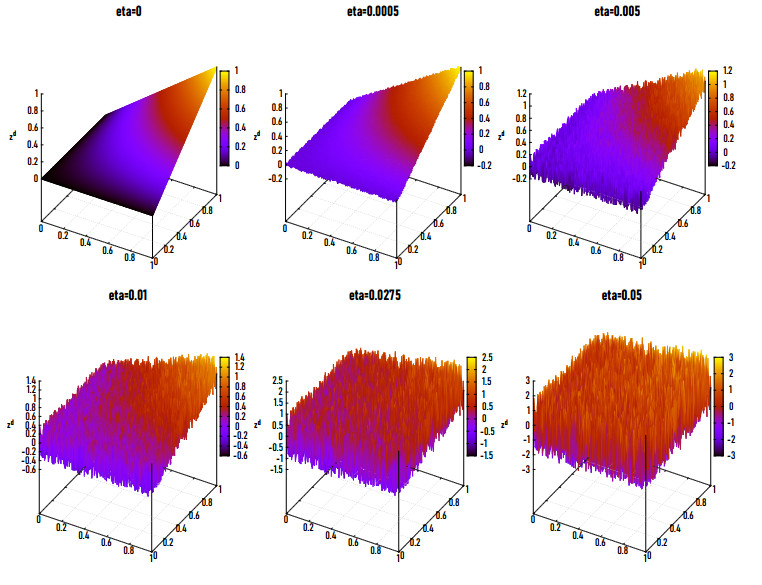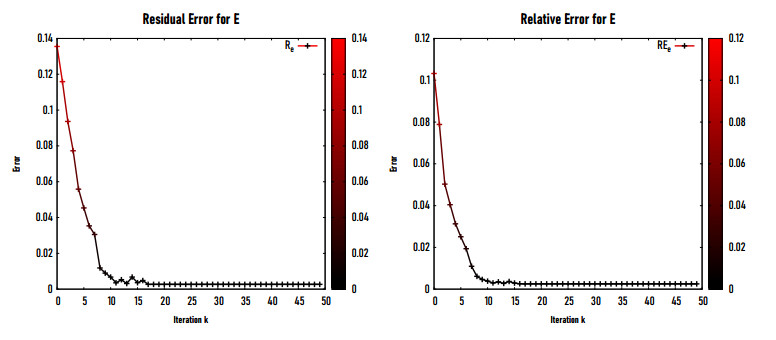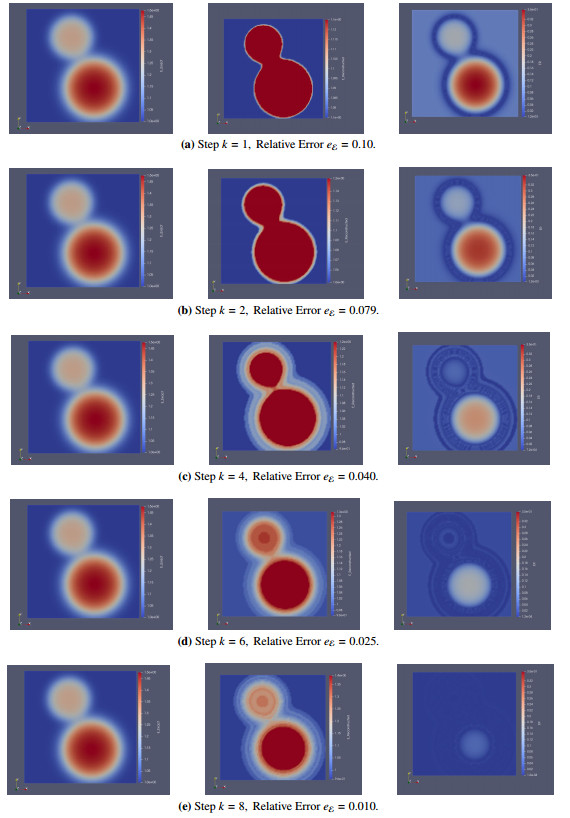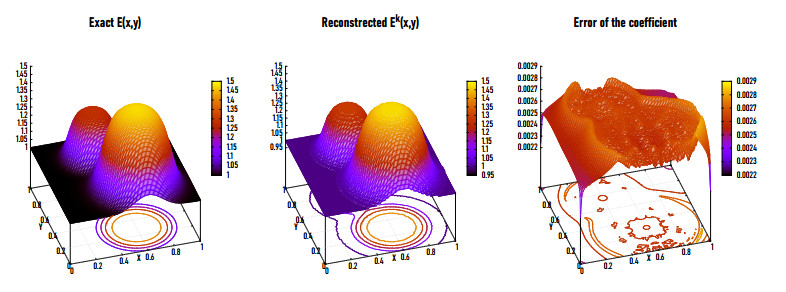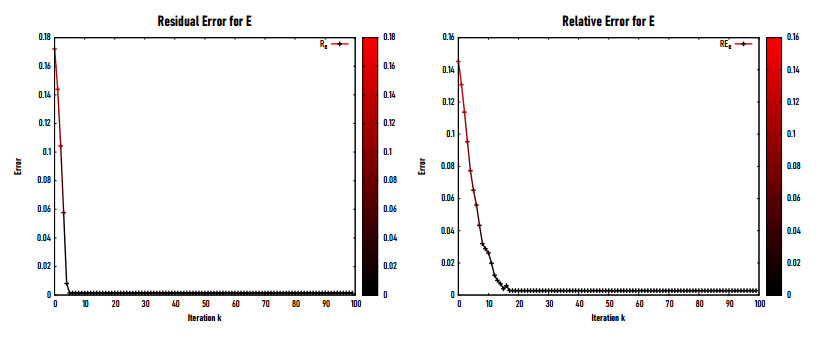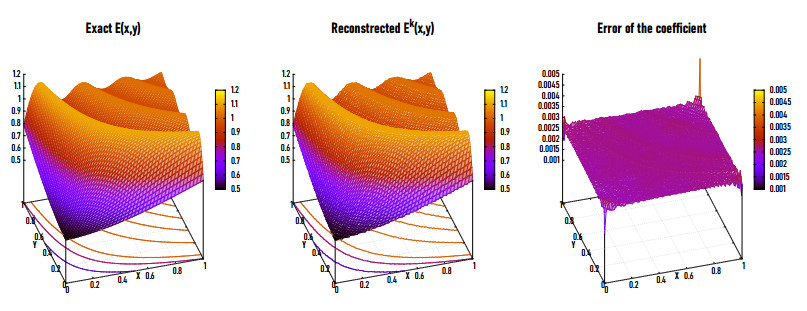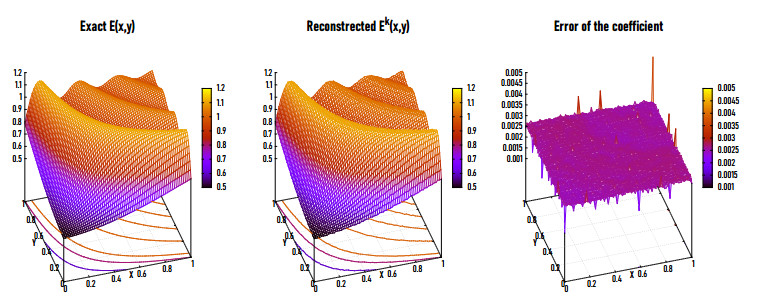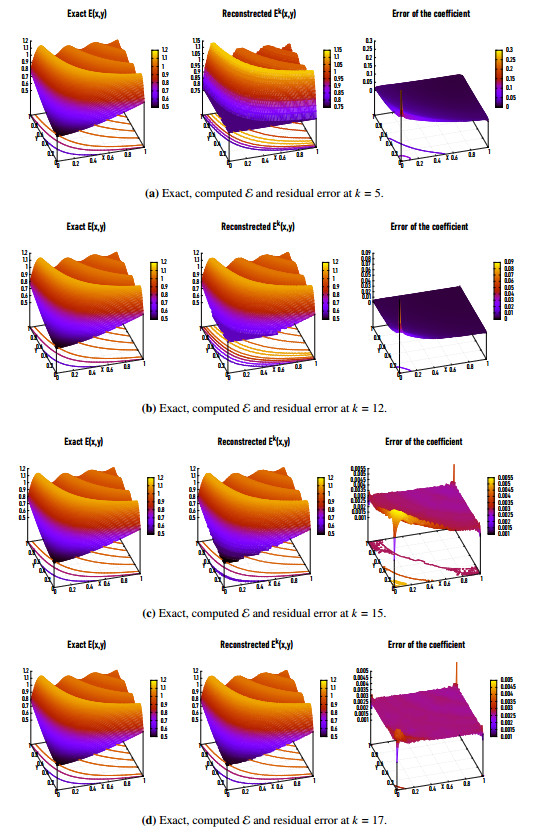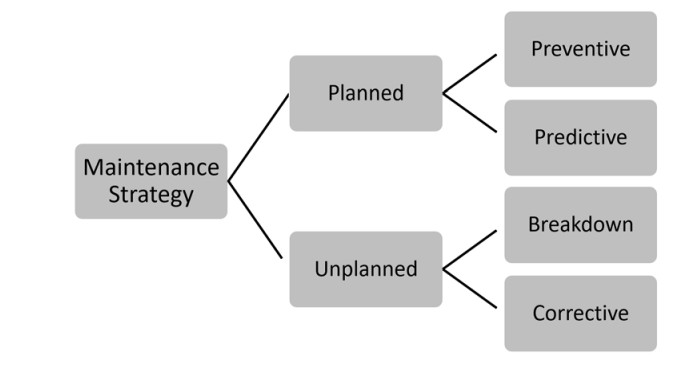|
[1]
|
A. Muller, A. C. Marquez, B. Iung, On the concept of e-maintenance: Review and current research, Reliab. Eng. Syst. Saf., 93 (2008), 1165–1187. https://doi.org/10.1016/j.ress.2007.08.006 doi: 10.1016/j.ress.2007.08.006

|
|
[2]
|
K. Gandhi, A. H. Ng, Machine maintenance decision support system: a systematic literature review, in Advances in Manufacturing Technology XXXⅡ: Proceedings of the 16th International Conference on Manufacturing Research, incorporating the 33rd National Conference on Manufacturing Research, September 11–13, University of Skö vde, IOS Press, Sweden, 8 (2018), 349.
|
|
[3]
|
A. Garg, S. G. Deshmukh, Maintenance management: literature review and directions, J. Qual. Maint. Eng., 12 (2006), 205–238. https://doi.org/10.1108/13552510610685075 doi: 10.1108/13552510610685075

|
|
[4]
|
D. Sherwin, A review of overall models for maintenance management, J. Qual. Maint. Eng., 6 (2000), 138–164. https://doi.org/10.1108/13552510010341171 doi: 10.1108/13552510010341171

|
|
[5]
|
K. C. Ng, G. G. G. Goh, U. C. Eze, Critical success factors of total productive maintenance implementation: a review, in 2011 IEEE international conference on industrial engineering and engineering management, IEEE, Singapore, 269–273. https://doi.org/10.1109/IEEM.2011.6117920
|
|
[6]
|
E. Sisinni, A. Saifullah, S. Han, U. Jennehag, M. Gidlund, Industrial internet of things: Challenges, opportunities, and directions, IEEE Trans. Ind. Inf., 14 (2018), 4724–4734. https://doi.org/10.1109/TⅡ.2018.2852491 doi: 10.1109/TⅡ.2018.2852491

|
|
[7]
|
H. Boyes, B. Hallaq, J. Cunningham, T. Watson, The industrial internet of things (ⅡoT): An analysis framework, Comput. Ind., 101 (2018), 1–12. https://doi.org/10.1016/j.compind.2018.04.015 doi: 10.1016/j.compind.2018.04.015

|
|
[8]
|
J. Wan, S. Tang, Z. Shu, D. Li, S. Wang, M. Imran, et al., Software-defined industrial internet of things in the context of industry 4.0, IEEE Sens. J., 16 (2016), 7373–7380. https://doi.org/10.1109/JSEN.2016.2565621 doi: 10.1109/JSEN.2016.2565621

|
|
[9]
|
Y. Liao, E. D. F. R. Loures, F. Deschamps, Industrial Internet of Things: A systematic literature review and insights, IEEE Internet Things J., 5 (2018), 4515–4525. https://doi.org/10.1109/JIOT.2018.2834151 doi: 10.1109/JIOT.2018.2834151

|
|
[10]
|
M. Hartmann, B. Halecker, Management of innovation in the industrial internet of things, in The International Society for Professional Innovation Management ISPIM Conference Proceedings, 2015.
|
|
[11]
|
M. Mohri, A. Rostamizadeh, A. Talwalkar, Foundations of Machine Learning, MIT press, 2018.
|
|
[12]
|
C. Sammut, G. I. Webb, Encyclopedia of Machine Learning, Springer Science & Business Media, 2011.
|
|
[13]
|
G. Carleo, I. Cirac, K. Cranmer, L. Daudet, M. Schuld, N. Tishby, et al., Machine learning and the physical sciences, Rev. Mod. Phys., 91 (2019), 045002. https://doi.org/10.1103/RevModPhys.91.045002 doi: 10.1103/RevModPhys.91.045002

|
|
[14]
|
M. Du, N. Liu, X. Hu, Techniques for interpretable machine learning, Commun. ACM, 63 (2019), 68–77. https://doi.org/10.1145/3359786 doi: 10.1145/3359786

|
|
[15]
|
H. Sahli, An introduction to machine learning, in TORUS 1-Toward an Open Resource Using Services: Cloud Computing for Environmental Data, (2020), 61–74. https://doi.org/10.1002/9781119720492.ch7
|
|
[16]
|
R. H. P. M. Arts, G. M. Knapp, L. Mann, Some aspects of measuring maintenance performance in the process industry, J. Qual. Maint. Eng., 4 (1998) 6–11. https://doi.org/10.1108/13552519810201520 doi: 10.1108/13552519810201520

|
|
[17]
|
C. Stenströ m, P. Norrbin, A. Parida, U. Kumar, Preventive and corrective maintenance-cost comparison and cost-benefit analysis, Struct. Infrastruct. Eng., 12 (2016), 603–617. https://doi.org/10.1080/15732479.2015.1032983 doi: 10.1080/15732479.2015.1032983

|
|
[18]
|
H. P. Bahrick, L. K. Hall, Preventive and corrective maintenance of access to knowledge, Appl. Cognit. Psychol., 5 (1991), 1–18. https://doi.org/10.1002/acp.2350050102 doi: 10.1002/acp.2350050102

|
|
[19]
|
J. Shin, H. Jun, On condition based maintenance policy, J. Comput. Des. Eng., 2 (2015), 119–127. https://doi.org/10.1016/j.jcde.2014.12.006 doi: 10.1016/j.jcde.2014.12.006

|
|
[20]
|
R. Ahmad, S. Kamaruddin, An overview of time-based and condition-based maintenance in industrial application, Comput. Ind. Eng., 63 (2012), 135–149. https://doi.org/10.1016/j.cie.2012.02.002 doi: 10.1016/j.cie.2012.02.002

|
|
[21]
|
J. H. Williams, A. Davies, P. R. Drake, Condition-Based Maintenance and Machine Diagnostics, Springer Science & Business Media, 1994.
|
|
[22]
|
R. K. Mobley, An Introduction to Predictive Maintenance, 2nd edition, Elsevier, 2002. https://doi.org/10.1016/B978-0-7506-7531-4.X5000-3
|
|
[23]
|
C. Scheffer, P. Girdhar, Practical Machinery Vibration Analysis and Predictive Maintenance, Elsevier, 2004.
|
|
[24]
|
K. Efthymiou, N. Papakostas, D. Mourtzis, G. Chryssolouris, On a predictive maintenance platform for production systems, Procedia CIRP, 3 (2012), 221–226. https://doi.org/10.1016/j.procir.2012.07.039 doi: 10.1016/j.procir.2012.07.039

|
|
[25]
|
G. A. Susto, A. Schirru, S. Pampuri, S. McLoone, A. Beghi, Machine learning for predictive maintenance: A multiple classifier approach, IEEE Trans. Ind. Inf., 11 (2014), 812–820. https://doi.org/10.1109/TⅡ.2014.2349359 doi: 10.1109/TⅡ.2014.2349359

|
|
[26]
|
R. Isermann, Fault-Diagnosis Systems: An Introduction from Fault Detection to Fault Tolerance, Springer Science & Business Media, 2005.
|
|
[27]
|
Z. Gao, C. Cecati, S. X. Ding, A survey of fault diagnosis and fault-tolerant techniques—Part I: Fault diagnosis with model-based and signal-based approaches, IEEE Trans. Ind. Electron., 62 (2015), 3757–3767. https://doi.org/10.1109/TIE.2015.2417501 doi: 10.1109/TIE.2015.2417501

|
|
[28]
|
S. Leonhardt, M. Ayoubi, Methods of fault diagnosis, Control Eng. Pract., 5 (1997), 683–692. https://doi.org/10.1016/S0967-0661(97)00050-6 doi: 10.1016/S0967-0661(97)00050-6

|
|
[29]
|
R. J. Patton, P. M. Frank, R. N Clark, Issues of Fault Diagnosis for Dynamic Systems, Springer Science & Business Media, 2013.
|
|
[30]
|
M. I. Jordan, T. M. Mitchell, Machine learning: Trends, perspectives, and prospects, Science, 349 (2015), 255–260. https://doi.org/10.1126/science.aaa8415 doi: 10.1126/science.aaa8415

|
|
[31]
|
U. S. Shanthamallu, A. Spanias, C. Tepedelenlioglu, M. Stanley, A brief survey of machine learning methods and their sensor and IoT applications, in 2017 8th International Conference on Information, Intelligence, Systems & Applications (ⅡSA), IEEE, (2017), 1–8. https://doi.org/10.1109/ⅡSA.2017.8316459
|
|
[32]
|
D. A. Pisner, D. M. Schnyer, Support vector machine, in Machine Learning, Academic Press, (2020), 101–121. https://doi.org/10.1016/B978-0-12-815739-8.00006-7
|
|
[33]
|
W. S. Noble, What is a support vector machine, Nat. Biotechnol., 24 (2006), 1565–1567. https://doi.org/10.1038/nbt1206-1565 doi: 10.1038/nbt1206-1565

|
|
[34]
|
L. Wang, Support Vector Machines: Theory and Applications, Springer Science & Business Media, 2005. https://doi.org/10.1007/b95439
|
|
[35]
|
S. I. Amari, S. Wu, Improving support vector machine classifiers by modifying kernel functions, Neural Networks, 12 (1999), 783–789. https://doi.org/10.1016/S0893-6080(99)00032-5 doi: 10.1016/S0893-6080(99)00032-5

|
|
[36]
|
O. L. Mangasarian, D. R. Musicant, Lagrangian support vector machines, J. Mach. Learn. Res., 1 (2001), 161–177.
|
|
[37]
|
A. Widodo, B. S. Yang, Support vector machine in machine condition monitoring and fault diagnosis, Mech. Syst. Sig. Process., 21 (2007), 2560–2574. https://doi.org/10.1016/j.ymssp.2006.12.007 doi: 10.1016/j.ymssp.2006.12.007

|
|
[38]
|
S. W. Fei, X. B. Zhang, Fault diagnosis of power transformer based on support vector machine with genetic algorithm, Expert Syst. Appl., 36 (2009), 11352–11357. https://doi.org/10.1016/j.eswa.2009.03.022 doi: 10.1016/j.eswa.2009.03.022

|
|
[39]
|
S. D. Wu, P. H. Wu, C. W. Wu, J. J. Ding, C. C. Wang, Bearing fault diagnosis based on multiscale permutation entropy and support vector machine, Entropy, 14 (2012), 1343–1356. https://doi.org/10.3390/e14081343 doi: 10.3390/e14081343

|
|
[40]
|
W. Aziz, M. Arif, Multiscale permutation entropy of physiological time series, in 2005 Pakistan Section Multitopic Conference, IEEE, (2005), 1–6. https://doi.org/10.1109/INMIC.2005.334494
|
|
[41]
|
B. Tang, T. Song, F. Li, L. Deng, Fault diagnosis for a wind turbine transmission system based on manifold learning and Shannon wavelet support vector machine, Renewable Energy, 62 (2014), 1–9. https://doi.org/10.1016/j.renene.2013.06.025 doi: 10.1016/j.renene.2013.06.025

|
|
[42]
|
Z. Wang, L. Yao, Y. Cai, J. Zhang, Mahalanobis semi-supervised mapping and beetle antennae search based support vector machine for wind turbine rolling bearings fault diagnosis, Renewable Energy, 155 (2020), 1312–1327. https://doi.org/10.1016/j.renene.2020.04.041 doi: 10.1016/j.renene.2020.04.041

|
|
[43]
|
L. Yao, Z. Fang, Y. Xiao, J. Hou, Z. Fu, An intelligent fault diagnosis method for lithium battery systems based on grid search support vector machine, Energy, 214 (2021), 118866. https://doi.org/10.1016/j.energy.2020.118866 doi: 10.1016/j.energy.2020.118866

|
|
[44]
|
Y. P. Zhao, J. J. Wang, X. Y. Li, G. J. Peng, Z. Yang, Extended least squares support vector machine with applications to fault diagnosis of aircraft engine, ISA Trans., 97 (2020), 189–201. https://doi.org/10.1016/j.isatra.2019.08.036 doi: 10.1016/j.isatra.2019.08.036

|
|
[45]
|
F. Marini, B. Walczak, Particle swarm optimization (PSO). A tutorial, Chemom. Intell. Lab. Syst., 149 (2015), 153–165. https://doi.org/10.1016/j.chemolab.2015.08.020 doi: 10.1016/j.chemolab.2015.08.020

|
|
[46]
|
M. Van, D. T. Hoang, H. J. Kang, Bearing fault diagnosis using a particle swarm optimization-least squares wavelet support vector machine classifier, Sensors, 20 (2020), 3422. https://doi.org/10.3390/s20123422 doi: 10.3390/s20123422

|
|
[47]
|
X. Li, S. Wu, X. Li, H. Yuan, D. Zhao, Particle swarm optimization-support vector machine model for machinery fault diagnoses in high-voltage circuit breakers, Chin. J. Mech. Eng., 33 (2020), 1–10. https://doi.org/10.1186/s10033-019-0428-5 doi: 10.1186/s10033-019-0428-5

|
|
[48]
|
Y. Fan, C. Zhang, Y. Xue, J. Wang, F. Gu, A bearing fault diagnosis using a support vector machine optimised by the self-regulating particle swarm, Shock Vib., 2020 (2020). https://doi.org/10.1155/2020/9096852 doi: 10.1155/2020/9096852

|
|
[49]
|
E. Mirakhorli, Fault diagnosis in a distillation column using a support vector machine based classifier, Int. J. Smart Electr. Eng., 8 (2020), 105–113.
|
|
[50]
|
S. Gao, C. Zhou, Z. Zhang, J. Geng, R. He, Q. Yin, C. Xing, Mechanical fault diagnosis of an on-load tap changer by applying cuckoo search algorithm-based fuzzy weighted least squares support vector machine, Math. Probl. Eng., 2020 (2020). https://doi.org/10.1155/2020/3432409 doi: 10.1155/2020/3432409

|
|
[51]
|
X. Huang, X. Huang, B. Wang, Z. Xie, Fault diagnosis of transformer based on modified grey wolf optimization algorithm and support vector machine, IEEJ Trans. Electr. Electron. Eng., 15 (2020), 409–417. https://doi.org/10.1002/tee.23069 doi: 10.1002/tee.23069

|
|
[52]
|
Y. Zhang, J. Li, X. Fan, J. Liu, H. Zhang, Moisture prediction of transformer oil-immersed polymer insulation by applying a support vector machine combined with a genetic algorithm, Polymers, 12 (2020), 1579. https://doi.org/10.3390/polym12071579 doi: 10.3390/polym12071579

|
|
[53]
|
Y. Liu, H. Chen, L. Zhang, X. Wu, X. J. Wang, Energy consumption prediction and diagnosis of public buildings based on support vector machine learning: A case study in China, J. Cleaner Prod., 272 (2020), 122542. https://doi.org/10.1016/j.jclepro.2020.122542 doi: 10.1016/j.jclepro.2020.122542

|
|
[54]
|
S. K. Ibrahim, A. Ahmed, M. A. E. Zeidan, I. E. Ziedan, Machine learning techniques for satellite fault diagnosis, Ain Shams Eng. J., 11 (2020), 45–56. https://doi.org/10.1016/j.asej.2019.08.006 doi: 10.1016/j.asej.2019.08.006

|
|
[55]
|
Y. P. Zhao, G. Huang, Q. K. Hu, B. Li, An improved weighted one class support vector machine for turboshaft engine fault detection, Eng. Appl. Artif. Intell., 94 (2020), 103796. https://doi.org/10.1016/j.engappai.2020.103796 doi: 10.1016/j.engappai.2020.103796

|
|
[56]
|
M. Guo, L. Xie, S. Q. Wang, J. M. Zhang, Research on an integrated ICA-SVM based framework for fault diagnosis, in SMC'03 Conference Proceedings. 2003 IEEE International Conference on Systems, Man and Cybernetics. Conference Theme-System Security and Assurance (Cat. No. 03CH37483), IEEE, 3 (2003), 2710–2715. https://doi.org/10.1109/ICSMC.2003.1244294
|
|
[57]
|
S. Poyhonen, P. Jover, H. Hyotyniemi, Signal processing of vibrations for condition monitoring of an induction motor, in First International Symposium on Control, Communications and Signal Processing, IEEE, Tunisia, (2004), 499–502. https://doi.org/10.1109/ISCCSP.2004.1296338
|
|
[58]
|
M. C. Moura, E. Zio, I. D. Lins, E. Droguett, Failure and reliability prediction by support vector machines regression of time series data, Reliab. Eng. Syst. Saf., 96 (2011), 1527–1534. https://doi.org/10.1016/j.ress.2011.06.006 doi: 10.1016/j.ress.2011.06.006

|
|
[59]
|
K. Y. Chen, L. S. Chen, M. C. Chen, C. L. Lee, Using SVM based method for equipment fault detection in a thermal power plant, Comput. Ind., 62 (2011), 42–50. https://doi.org/10.1016/j.compind.2010.05.013 doi: 10.1016/j.compind.2010.05.013

|
|
[60]
|
K. He, X. Li, A quantitative estimation technique for welding quality using local mean decomposition and support vector machine, J. Intell. Manuf., 27 (2016), 525–533. https://doi.org/10.1007/s10845-014-0885-8 doi: 10.1007/s10845-014-0885-8

|
|
[61]
|
K. Yan, C. Zhong, Z. Ji, J. Huang, Semi-supervised learning for early detection and diagnosis of various air handling unit faults, Energy Build., 181 (2018), 75–83. https://doi.org/10.1016/j.enbuild.2018.10.016 doi: 10.1016/j.enbuild.2018.10.016

|
|
[62]
|
Z. Yin, J. Hou, Recent advances on SVM based fault diagnosis and process monitoring in complicated industrial processes, Neurocomputing, 174 (2016), 643–650. https://doi.org/10.1016/j.neucom.2015.09.081 doi: 10.1016/j.neucom.2015.09.081

|
|
[63]
|
M. M. Islam, J. M. Kim, Reliable multiple combined fault diagnosis of bearings using heterogeneous feature models and multiclass support vector Machines, Reliab. Eng. Syst. Saf., 184 (2019), 55–66. https://doi.org/10.1016/j.ress.2018.02.012 doi: 10.1016/j.ress.2018.02.012

|
|
[64]
|
R. P. Monteiro, M. Cerrada, D. R. Cabrera, R. V. Sánchez, C. J. Bastos-Filho, Using a support vector machine based decision stage to improve the fault diagnosis on gearboxes, Comput. Intell. Neurosci., 2019 (2019). https://doi.org/10.1155/2019/1383752 doi: 10.1155/2019/1383752

|
|
[65]
|
D. Yang, J. Miao, F. Zhang, J. Tao, G. Wang, Y. Shen, Bearing fault diagnosis using a support vector machine optimized by an improved ant lion optimizer, Shock Vib., 2019 (2019). https://doi.org/10.1155/2019/9303676 doi: 10.1155/2019/9303676

|
|
[66]
|
S. Mirjalili, The ant lion optimizer, Adv. Eng. Software, 83 (2015), 80–98. https://doi.org/10.1016/j.advengsoft.2015.01.010 doi: 10.1016/j.advengsoft.2015.01.010

|
|
[67]
|
L. You, W. Fan, Z. Li, Y. Liang, M. Fang, J. Wang, A fault diagnosis model for rotating machinery using VWC and MSFLA-SVM based on vibration signal analysis, Shock Vib., 2019 (2019). https://doi.org/10.1155/2019/1908485 doi: 10.1155/2019/1908485

|
|
[68]
|
A. Kumar, R. Kumar, Time-frequency analysis and support vector machine in automatic detection of defect from vibration signal of centrifugal pump, Measurement, 108 (2017), 119–133. https://doi.org/10.1016/j.measurement.2017.04.041 doi: 10.1016/j.measurement.2017.04.041

|
|
[69]
|
Z. Chen, F. Zhao, J. Zhou, P. Huang, X. Zhang, Fault diagnosis of loader gearbox based on an Ica and SVM algorithm, Int. J. Environ. Res. Public Health, 16 (2019), 4868. https://doi.org/10.3390/ijerph16234868 doi: 10.3390/ijerph16234868

|
|
[70]
|
T. W. Lee, Independent component analysis, in Independent Component Analysis, Springer, Boston, (1998), 27–66. https://doi.org/10.1007/978-1-4757-2851-4_2
|
|
[71]
|
W. Liu, Z. Wang, J. Han, G. Wang, Wind turbine fault diagnosis method based on diagonal spectrum and clustering binary tree SVM, Renewable Energy, 50 (2013), 1–6. https://doi.org/10.1016/j.renene.2012.06.013 doi: 10.1016/j.renene.2012.06.013

|
|
[72]
|
M. A. Djeziri, O. Djedidi, N. Morati, J. L. Seguin, M. Bendahan, T. Contaret, A temporal-based SVM approach for the detection and identification of pollutant gases in a gas mixture, Appl. Intell., 52 (2022), 6065–6078. https://doi.org/10.1007/s10489-021-02761-0 doi: 10.1007/s10489-021-02761-0

|
|
[73]
|
G. Ciaburro, G. Iannace, J. Passaro, A. Bifulco, D. Marano, M. Guida, et al., Artificial neural network-based models for predicting the sound absorption coefficient of electrospun poly (vinyl pyrrolidone)/silica composite, Appl. Acoust., 169 (2020), 107472. https://doi.org/10.1016/j.apacoust.2020.107472 doi: 10.1016/j.apacoust.2020.107472

|
|
[74]
|
S. Agatonovic-Kustrin, R. Beresford, Basic concepts of artificial neural network (ANN) modeling and its application in pharmaceutical research, J. Pharm. Biomed. Anal., 22 (2000), 717–727. https://doi.org/10.1016/S0731-7085(99)00272-1 doi: 10.1016/S0731-7085(99)00272-1

|
|
[75]
|
G. Ciaburro, G. Iannace, M. Ali, A. Alabdulkarem, A. Nuhait, An artificial neural network approach to modelling absorbent asphalts acoustic properties, J. King Saud Univ. Eng. Sci., 33 (2021), 213–220. https://doi.org/10.1016/j.jksues.2020.07.002 doi: 10.1016/j.jksues.2020.07.002

|
|
[76]
|
J. Misra, I. Saha, Artificial neural networks in hardware: A survey of two decades of progress, Neurocomputing, 74 (2010), 239–255. https://doi.org/10.1016/j.neucom.2010.03.021 doi: 10.1016/j.neucom.2010.03.021

|
|
[77]
|
Z. Zhang, K. Friedrich, Artificial neural networks applied to polymer composites: a review, Compos. Sci. Technol., 63 (2003), 2029–2044. https://doi.org/10.1016/S0266-3538(03)00106-4 doi: 10.1016/S0266-3538(03)00106-4

|
|
[78]
|
G. Iannace, G. Ciaburro, A. Trematerra, Modelling sound absorption properties of broom fibers using artificial neural networks, Appl. Acoust., 163 (2020), 107239. https://doi.org/10.1016/j.apacoust.2020.107239 doi: 10.1016/j.apacoust.2020.107239

|
|
[79]
|
K. P. Singh, A. Basant, A. Malik, G. Jain, Artificial neural network modeling of the river water quality—a case study, Ecol. Modell., 220 (2009), 888–895. https://doi.org/10.1016/j.ecolmodel.2009.01.004 doi: 10.1016/j.ecolmodel.2009.01.004

|
|
[80]
|
H. Zhu, X. Li, Q. Sun, L. Nie, J. Yao, G. Zhao, A power prediction method for photovoltaic power plant based on wavelet decomposition and artificial neural networks, Energies, 9 (2015), 1–15. https://doi.org/10.3390/en9010011 doi: 10.3390/en9010011

|
|
[81]
|
V. P. Romero, L. Maffei, G. Brambilla, G. Ciaburro, Modelling the soundscape quality of urban waterfronts by artificial neural networks, Appl. Acoust., 111 (2016), 121–128. https://doi.org/10.1016/j.apacoust.2016.04.019 doi: 10.1016/j.apacoust.2016.04.019

|
|
[82]
|
S. Fabio, D. N. Giovanni, P. Mariano, Airborne sound insulation prediction of masonry walls using artificial neural networks, Build. Acoust., 28 (2021), 391–409. https://doi.org/10.1177/1351010X21994462 doi: 10.1177/1351010X21994462

|
|
[83]
|
Y. Zhang, X. Ding, Y. Liu, P. J. Griffin, An artificial neural network approach to transformer fault diagnosis, IEEE Trans. Power Delivery, 11 (1996), 1836–1841. https://doi.org/10.1109/61.544265 doi: 10.1109/61.544265

|
|
[84]
|
J. C. Hoskins, K. M. Kaliyur, D. M. Himmelblau, Fault diagnosis in complex chemical plants using artificial neural networks, AIChE J., 37 (1991), 137–141. https://doi.org/10.1002/aic.690370112 doi: 10.1002/aic.690370112

|
|
[85]
|
J. B. Ali, N. Fnaiech, L. Saidi, B. Chebel-Morello, F. Fnaiech, Application of empirical mode decomposition and artificial neural network for automatic bearing fault diagnosis based on vibration signals, Appl. Acoust., 89 (2015), 16–27. https://doi.org/10.1016/j.apacoust.2014.08.016 doi: 10.1016/j.apacoust.2014.08.016

|
|
[86]
|
T. Sorsa, H. N. Koivo, Application of artificial neural networks in process fault diagnosis, Automatica, 29 (1993), 843–849. https://doi.org/10.1016/0005-1098(93)90090-G doi: 10.1016/0005-1098(93)90090-G

|
|
[87]
|
N. Saravanan, K. I. Ramachandran, Incipient gear box fault diagnosis using discrete wavelet transform (DWT) for feature extraction and classification using artificial neural network (ANN), Expert Syst. Appl., 37 (2010), 4168–4181. https://doi.org/10.1016/j.eswa.2009.11.006 doi: 10.1016/j.eswa.2009.11.006

|
|
[88]
|
W. Chine, A. Mellit, V. Lughi, A. Malek, G. Sulligoi, A. M. Pavan, A novel fault diagnosis technique for photovoltaic systems based on artificial neural networks, Renewable Energy, 90 (2016), 501–512. https://doi.org/10.1016/j.renene.2016.01.036 doi: 10.1016/j.renene.2016.01.036

|
|
[89]
|
B. Li, M. Y. Chow, Y. Tipsuwan, J. C. Hung, Neural-network-based motor rolling bearing fault diagnosis, IEEE Trans. Ind. Electron., 47 (2000), 1060–1069. https://doi.org/10.1109/41.873214 doi: 10.1109/41.873214

|
|
[90]
|
B. Samanta, K. R. Al-Balushi, S. A. Al-Araimi, Artificial neural networks and genetic algorithm for bearing fault detection, Soft Comput., 10 (2006), 264–271. https://doi.org/10.1007/s00500-005-0481-0 doi: 10.1007/s00500-005-0481-0

|
|
[91]
|
T. Han, B. S. Yang, W. H. Choi, J. S. Kim, Fault diagnosis system of induction motors based on neural network and genetic algorithm using stator current signals, Int. J. Rotating Mach., 2006 (2006). https://doi.org/10.1155/IJRM/2006/61690 doi: 10.1155/IJRM/2006/61690

|
|
[92]
|
H. Wang, P. Chen, Intelligent diagnosis method for rolling element bearing faults using possibility theory and neural network, Comput. Ind. Eng., 60 (2011), 511–518. https://doi.org/10.1016/j.cie.2010.12.004 doi: 10.1016/j.cie.2010.12.004

|
|
[93]
|
M. A. Hashim, M. H. Nasef, A. E. Kabeel, N. M. Ghazaly, Combustion fault detection technique of spark ignition engine based on wavelet packet transform and artificial neural network, Alexandria Eng. J., 59 (2020), 3687–3697. https://doi.org/10.1016/j.aej.2020.06.023 doi: 10.1016/j.aej.2020.06.023

|
|
[94]
|
G. Iannace, G. Ciaburro, A. Trematerra, Fault diagnosis for UAV blades using artificial neural network, Robotics, 8 (2019), 59. https://doi.org/10.3390/robotics8030059 doi: 10.3390/robotics8030059

|
|
[95]
|
M. Kordestani, M. F. Samadi, M. Saif, K. Khorasani, A new fault diagnosis of multifunctional spoiler system using integrated artificial neural network and discrete wavelet transform methods, IEEE Sens. J., 18 (2018), 4990–5001. https://doi.org/10.1109/JSEN.2018.2829345 doi: 10.1109/JSEN.2018.2829345

|
|
[96]
|
S. Shi, G. Li, H. Chen, J. Liu, Y. Hu, L. Xing, et al., Refrigerant charge fault diagnosis in the VRF system using Bayesian artificial neural network combined with ReliefF filter, Appl. Therm. Eng., 112 (2017), 698–706. https://doi.org/10.1016/j.applthermaleng.2016.10.043 doi: 10.1016/j.applthermaleng.2016.10.043

|
|
[97]
|
X. Xu, D. Cao, Y. Zhou, J. Gao, Application of neural network algorithm in fault diagnosis of mechanical intelligence, Mech. Syst. Sig. Process., 141 (2020), 106625. https://doi.org/10.1016/j.ymssp.2020.106625 doi: 10.1016/j.ymssp.2020.106625

|
|
[98]
|
A. Viveros-Wacher, J. E. Rayas-Sánchez, Analog fault identification in RF circuits using artificial neural networks and constrained parameter extraction, in 2018 IEEE MTT-S International Conference on Numerical Electromagnetic and Multiphysics Modeling and Optimization (NEMO), IEEE, (2018), 1–3. https://doi.org/10.1109/NEMO.2018.8503117
|
|
[99]
|
S. Heo, J. H. Lee, Fault detection and classification using artificial neural networks, IFAC-PapersOnLine, 51 (2018), 470–475. https://doi.org/10.1016/j.ifacol.2018.09.380 doi: 10.1016/j.ifacol.2018.09.380

|
|
[100]
|
P. Agrawal, P. Jayaswal, Diagnosis and classifications of bearing faults using artificial neural network and support vector machine, J. Inst. Eng. (India): Ser. C, 101 (2020), 61–72. https://doi.org/10.1007/s40032-019-00519-9 doi: 10.1007/s40032-019-00519-9

|
|
[101]
|
Y. LeCun, B. E. Boser, J. S. Denker, D. Henderson, R. E. Howard, W. E. Hubbard, et al., Handwritten digit recognition with a back-propagation network, in Advances in Neural Information Processing Systems, (1990), 396–404.
|
|
[102]
|
T. Chen, Y. Sun, T. H. Li, A semi-parametric estimation method for the quantile spectrum with an application to earthquake classification using convolutional neural network, Comput. Stat. Data Anal., 154 (2021), 107069. https://doi.org/10.1016/j.csda.2020.107069 doi: 10.1016/j.csda.2020.107069

|
|
[103]
|
F. Perla, R. Richman, S. Scognamiglio, M. V. Wüthrich, Time-series forecasting of mortality rates using deep learning, Scand. Actuarial J., 2021 (2021), 1–27. https://doi.org/10.1080/03461238.2020.1867232 doi: 10.1080/03461238.2020.1867232

|
|
[104]
|
G. Ciaburro, G. Iannace, V. Puyana-Romero, A. Trematerra, A comparison between numerical simulation models for the prediction of acoustic behavior of giant reeds shredded, Appl. Sci., 10 (2020), 6881. https://doi.org/10.3390/app10196881 doi: 10.3390/app10196881

|
|
[105]
|
C. Yildiz, H. Acikgoz, D. Korkmaz, U. Budak, An improved residual-based convolutional neural network for very short-term wind power forecasting, Energy Convers. Manage., 228 (2021), 113731. https://doi.org/10.1016/j.enconman.2020.113731 doi: 10.1016/j.enconman.2020.113731

|
|
[106]
|
G. Ciaburro, Sound event detection in underground parking garage using convolutional neural network, Big Data Cognit. Comput., 4 (2020), 20. https://doi.org/10.3390/bdcc4030020 doi: 10.3390/bdcc4030020

|
|
[107]
|
R. Ye, Q. Dai, Implementing transfer learning across different datasets for time series forecasting, Pattern Recognit., 109 (2021), 107617. https://doi.org/10.1016/j.patcog.2020.107617 doi: 10.1016/j.patcog.2020.107617

|
|
[108]
|
J. Han, L. Shi, Q. Yang, K. Huang, Y. Zha, J. Yu, Real-time detection of rice phenology through convolutional neural network using handheld camera images, Precis. Agric., 22 (2021), 154–178. https://doi.org/10.1016/j.patcog.2020.107617 doi: 10.1016/j.patcog.2020.107617

|
|
[109]
|
G. Ciaburro, G. Iannace, Improving smart cities safety using sound events detection based on deep neural network algorithms, Informatics, 7 (2020), 23. https://doi.org/10.3390/informatics7030023 doi: 10.3390/informatics7030023

|
|
[110]
|
L. Wen, X. Li, L. Gao, Y. Zhang, A new convolutional neural network-based data-driven fault diagnosis method, IEEE Trans. Ind. Electron., 65 (2017), 5990–5998. https://doi.org/10.1109/TIE.2017.2774777 doi: 10.1109/TIE.2017.2774777

|
|
[111]
|
Y. LeCun, LeNet-5, Convolutional Neural Networks, 2015, Available from: http://yann.lecun.com/exdb/lenet/, Accessed date: 28 April 2022.
|
|
[112]
|
H. Wu, J. Zhao, Deep convolutional neural network model based chemical process fault diagnosis, Comput. Chem. Eng., 115 (2018), 185–197. https://doi.org/10.1016/j.compchemeng.2018.04.009 doi: 10.1016/j.compchemeng.2018.04.009

|
|
[113]
|
W. Zhang, C. Li, G. Peng, Y. Chen, Z. Zhang, A deep convolutional neural network with new training methods for bearing fault diagnosis under noisy environment and different working load, Mech. Syst. Sig. Process., 100 (2018), 439–453. https://doi.org/10.1016/j.ymssp.2017.06.022 doi: 10.1016/j.ymssp.2017.06.022

|
|
[114]
|
L. Jing, M. Zhao, P. Li, X. Xu, A convolutional neural network based feature learning and fault diagnosis method for the condition monitoring of gearbox, Measurement, 111 (2017), 1–10. https://doi.org/10.1016/j.measurement.2017.07.017 doi: 10.1016/j.measurement.2017.07.017

|
|
[115]
|
Z. Chen, C. Li, R. V. Sanchez, Gearbox fault identification and classification with convolutional neural networks, Shock Vib., 2015 (2015). https://doi.org/10.1155/2015/390134 doi: 10.1155/2015/390134

|
|
[116]
|
X. Guo, L. Chen, C. Shen, Hierarchical adaptive deep convolution neural network and its application to bearing fault diagnosis, Measurement, 93 (2016), 490–502. https://doi.org/10.1016/j.measurement.2016.07.054 doi: 10.1016/j.measurement.2016.07.054

|
|
[117]
|
O. Janssens, V. Slavkovikj, B. Vervisch, K. Stockman, M. Loccufier, S. Verstockt, et al., Convolutional neural network based fault detection for rotating machinery, J. Sound Vib., 377 (2016), 331–345. https://doi.org/10.1016/j.jsv.2016.05.027 doi: 10.1016/j.jsv.2016.05.027

|
|
[118]
|
W. Zhang, G. Peng, C. Li, Y. Chen, Z. Zhang, A new deep learning model for fault diagnosis with good anti-noise and domain adaptation ability on raw vibration signals, Sensors, 17 (2017), 425. https://doi.org/10.3390/s17020425 doi: 10.3390/s17020425

|
|
[119]
|
Y. Li, N. Wang, J. Shi, X. Hou, J. Liu, Adaptive batch normalization for practical domain adaptation, Pattern Recognit., 80 (2018), 109–117. https://doi.org/10.1016/j.patcog.2018.03.005 doi: 10.1016/j.patcog.2018.03.005

|
|
[120]
|
T. Ince, S. Kiranyaz, L. Eren, M. Askar, M. Gabbouj, Real-time motor fault detection by 1-D convolutional neural networks, IEEE Trans. Ind. Electron., 63 (2016), 7067–7075. https://doi.org/10.1109/TIE.2016.2582729 doi: 10.1109/TIE.2016.2582729

|
|
[121]
|
Y. Zhang, K. Xing, R. Bai, D. Sun, Z. Meng, An enhanced convolutional neural network for bearing fault diagnosis based on time-frequency image, Measurement, 157 (2020), 107667. https://doi.org/10.1016/j.measurement.2020.107667 doi: 10.1016/j.measurement.2020.107667

|
|
[122]
|
M. Azamfar, J. Singh, I. Bravo-Imaz, J. Lee, . Multisensor data fusion for gearbox fault diagnosis using 2-D convolutional neural network and motor current signature analysis, Mech. Syst. Sig. Process., 144 (2020), 106861. https://doi.org/10.1016/j.ymssp.2020.106861 doi: 10.1016/j.ymssp.2020.106861

|
|
[123]
|
Q. Zhou, Y. Li, Y. Tian, L. Jiang, A novel method based on nonlinear auto-regression neural network and convolutional neural network for imbalanced fault diagnosis of rotating machinery, Measurement, 161 (2020), 107880. https://doi.org/10.1016/j.measurement.2020.107880 doi: 10.1016/j.measurement.2020.107880

|
|
[124]
|
K. Zhang, J. Chen, T. Zhang, Z. Zhou, A compact convolutional neural network augmented with multiscale feature extraction of acquired monitoring data for mechanical intelligent fault diagnosis, J. Manuf. Syst., 55 (2020), 273–284. https://doi.org/10.1016/j.jmsy.2020.04.016 doi: 10.1016/j.jmsy.2020.04.016

|
|
[125]
|
Y. Li, X. Du, F. Wan, X. Wang, H. Yu, Rotating machinery fault diagnosis based on convolutional neural network and infrared thermal imaging, Chin. J. Aeronaut., 33 (2020), 427–438. https://doi.org/10.1016/j.cja.2019.08.014 doi: 10.1016/j.cja.2019.08.014

|
|
[126]
|
Z. Chen, A. Mauricio, W. Li, K. Gryllias, A deep learning method for bearing fault diagnosis based on cyclic spectral coherence and convolutional neural networks, Mech. Syst. Sig. Process., 140 (2020), 106683. https://doi.org/10.1016/j.ymssp.2020.106683 doi: 10.1016/j.ymssp.2020.106683

|
|
[127]
|
J. Antoni, Cyclic spectral analysis in practice, Mech. Syst. Sig. Process., 21 (2007), 597–630. https://doi.org/10.1016/j.ymssp.2006.08.007 doi: 10.1016/j.ymssp.2006.08.007

|
|
[128]
|
D. Zhou, Q. Yao, H. Wu, S. Ma, H. Zhang, Fault diagnosis of gas turbine based on partly interpretable convolutional neural networks, Energy, 200 (2020), 117467. https://doi.org/10.1016/j.energy.2020.117467 doi: 10.1016/j.energy.2020.117467

|
|
[129]
|
T. Chen, T. He, M. Benesty, V. Khotilovich, Y. Tang, H. Cho, Xgboost: extreme gradient boosting, R package version 0.4-2, 1 (2015), 1–4.
|
|
[130]
|
X. Li, J. Zheng, M. Li, W. Ma, Y. Hu, Frequency-domain fusing convolutional neural network: A unified architecture improving effect of domain adaptation for fault diagnosis, Sensors, 21 (2021), 450. https://doi.org/10.3390/s21020450 doi: 10.3390/s21020450

|
|
[131]
|
C. C. Chen, Z. Liu, G. Yang, C. C. Wu, Q. Ye, An improved fault diagnosis using 1D-convolutional neural network model, electronics, 10 (2021), 59. https://doi.org/10.3390/electronics10010059
|
|
[132]
|
Y. Liu, Y. Yang, T. Feng, Y. Sun, X. Zhang, Research on rotating machinery fault diagnosis method based on energy spectrum matrix and adaptive convolutional neural network, Processes, 9 (2021), 69. https://doi.org/10.3390/pr9010069 doi: 10.3390/pr9010069

|
|
[133]
|
D. T. Hoang, X. T. Tran, M. Van, H. J. Kang, A deep neural network-based feature fusion for bearing fault diagnosis, Sensors, 21 (2021), 244. https://doi.org/10.3390/s21010244 doi: 10.3390/s21010244

|
|
[134]
|
T. Mikolov, M. Karafiát, L. Burget, J. Černocký, S. Khudanpur, Recurrent neural network based language model, in Eleventh Annual Conference of the International Speech Communication Association, 2010.
|
|
[135]
|
K. Gregor, I. Danihelka, A. Graves, D. Rezende, D. Wierstra, Draw: A recurrent neural network for image generation, in International Conference on Machine Learning (PMLR), 37 (2015), 1462–1471.
|
|
[136]
|
T. Mikolov, G. Zweig, Context dependent recurrent neural network language model, in 2012 IEEE Spoken Language Technology Workshop (SLT), IEEE, (2012), 234–239. https://doi.org/10.1109/SLT.2012.6424228
|
|
[137]
|
G. Ciaburro, Time series data analysis using deep learning methods for smart cities monitoring, in Big Data Intelligence for Smart Applications, Springer, Cham, (2022), 93–116. https://doi.org/10.1007/978-3-030-87954-9_4
|
|
[138]
|
H. Sak, A. W. Senior, F. Beaufays, Long short-term memory recurrent neural network architectures for large scale acoustic modeling, Interspeech, (2014), 338–342. https://doi.org/10.21437/Interspeech.2014-80 doi: 10.21437/Interspeech.2014-80

|
|
[139]
|
J. Kim, J. Kim, H. L. T. Thu, H. Kim, Long short term memory recurrent neural network classifier for intrusion detection, in 2016 International Conference on Platform Technology and Service (PlatCon), IEEE, (2016), 1–5. https://doi.org/10.1109/PlatCon.2016.7456805
|
|
[140]
|
Y. Tian, L. Pan, Predicting short-term traffic flow by long short-term memory recurrent neural network, in 2015 IEEE International Conference on Smart City/SocialCom/SustainCom (SmartCity), IEEE, (2015), 153–158. https://doi.org/10.1109/SmartCity.2015.63
|
|
[141]
|
H. Jiang, X. Li, H. Shao, K. Zhao, Intelligent fault diagnosis of rolling bearings using an improved deep recurrent neural network, Meas. Sci. Technol., 29 (2018), 065107. https://doi.org/10.1088/1361-6501/aab945 doi: 10.1088/1361-6501/aab945

|
|
[142]
|
T. De Bruin, K. Verbert, R. Babuška, Railway track circuit fault diagnosis using recurrent neural networks, IEEE Trans. Neural Networks Learn. Syst., 28 (2016), 523–533. https://doi.org/10.1109/TNNLS.2016.2551940 doi: 10.1109/TNNLS.2016.2551940

|
|
[143]
|
R. Yang, M. Huang, Q. Lu, M. Zhong, Rotating machinery fault diagnosis using long-short-term memory recurrent neural network, IFAC-PapersOnLine, 51 (2018), 228–232. https://doi.org/10.1016/j.ifacol.2018.09.582 doi: 10.1016/j.ifacol.2018.09.582

|
|
[144]
|
H. A. Talebi, K. Khorasani, S. Tafazoli, A recurrent neural-network-based sensor and actuator fault detection and isolation for nonlinear systems with application to the satellite's attitude control subsystem, IEEE Trans. Neural Networks, 20 (2008), 45–60. https://doi.org/10.1109/TNN.2008.2004373 doi: 10.1109/TNN.2008.2004373

|
|
[145]
|
S. Zhang, K. Bi, T. Qiu, Bidirectional recurrent neural network-based chemical process fault diagnosis, Ind. Eng. Chem. Res., 59 (2019), 824–834. https://doi.org/10.1021/acs.iecr.9b05885 doi: 10.1021/acs.iecr.9b05885

|
|
[146]
|
Z. An, S. Li, J. Wang, X. Jiang, A novel bearing intelligent fault diagnosis framework under time-varying working conditions using recurrent neural network, ISA Trans., 100 (2020), 155–170. https://doi.org/10.1016/j.isatra.2019.11.010 doi: 10.1016/j.isatra.2019.11.010

|
|
[147]
|
W. Liu, P. Guo, L. Ye, A low-delay lightweight recurrent neural network (LLRNN) for rotating machinery fault diagnosis, Sensors, 19 (2019), 3109. https://doi.org/10.3390/s19143109 doi: 10.3390/s19143109

|
|
[148]
|
K. Liang, N. Qin, D. Huang, Y. Fu, Convolutional recurrent neural network for fault diagnosis of high-speed train bogie, Complexity, 2018 (2018). https://doi.org/10.1155/2018/4501952 doi: 10.1155/2018/4501952

|
|
[149]
|
D. Huang, Y. Fu, N. Qin, S. Gao, Fault diagnosis of high-speed train bogie based on LSTM neural network, Sci. Chin. Inf. Sci., 64 (2021), 1–3. https://doi.org/10.1007/s11432-018-9543-8 doi: 10.1007/s11432-018-9543-8

|
|
[150]
|
H. Shahnazari, P. Mhaskar, J. M. House, T. I. Salsbury, Modeling and fault diagnosis design for HVAC systems using recurrent neural networks, Comput. Chem. Eng., 126 (2019), 189–203. https://doi.org/10.1016/j.compchemeng.2019.04.011 doi: 10.1016/j.compchemeng.2019.04.011

|
|
[151]
|
H. Shahnazari, Fault diagnosis of nonlinear systems using recurrent neural networks, Chem. Eng. Res. Des., 153 (2020), 233–245. https://doi.org/10.1016/j.cherd.2019.09.026 doi: 10.1016/j.cherd.2019.09.026

|
|
[152]
|
L. Guo, N. Li, F. Jia, Y. Lei, J. Lin, A recurrent neural network based health indicator for remaining useful life prediction of bearings, Neurocomputing, 240 (2017), 98–109. https://doi.org/10.1016/j.neucom.2017.02.045 doi: 10.1016/j.neucom.2017.02.045

|
|
[153]
|
M. Yuan, Y. Wu, L. Lin, Fault diagnosis and remaining useful life estimation of aero engine using LSTM neural network, in 2016 IEEE international conference on aircraft utility systems (AUS), IEEE, (2016), 135–140. https://doi.org/10.1109/AUS.2016.7748035
|
|
[154]
|
Z. Wu, H. Jiang, K. Zhao, X. Li, An adaptive deep transfer learning method for bearing fault diagnosis, Measurement, 151 (2020), 107227. https://doi.org/10.1016/j.measurement.2019.107227 doi: 10.1016/j.measurement.2019.107227

|
|
[155]
|
A. Yin, Y. Yan, Z. Zhang, C. Li, R. V. Sánchez, Fault diagnosis of wind turbine gearbox based on the optimized LSTM neural network with cosine loss, Sensors, 20 (2020), 2339. https://doi.org/10.3390/s20082339 doi: 10.3390/s20082339

|
|
[156]
|
M. Xia, X. Zheng, M. Imran, M. Shoaib, Data-driven prognosis method using hybrid deep recurrent neural network, Appl. Soft Comput., 93 (2020), 106351. https://doi.org/10.1016/j.asoc.2020.106351 doi: 10.1016/j.asoc.2020.106351

|
|
[157]
|
Z. Wang, Y. Dong, W. Liu, Z. Ma, A novel fault diagnosis approach for chillers based on 1-D convolutional neural network and gated recurrent unit, Sensors, 20 (2020), 2458. https://doi.org/10.3390/s20092458 doi: 10.3390/s20092458

|
|
[158]
|
R. Salakhutdinov, Learning deep generative models, Annu. Rev. Stat. Appl., 2 (2015), 361–385. https://doi.org/10.1146/annurev-statistics-010814-020120 doi: 10.1146/annurev-statistics-010814-020120

|
|
[159]
|
A. Gupta, A. Agarwal, P. Singh, P. Rai, A deep generative framework for paraphrase generation, in Proceedings of the AAAI Conference on Artificial Intelligence, 32 (2018). https://doi.org/10.1609/aaai.v32i1.11956
|
|
[160]
|
I. J. Goodfellow, J. Pouget-Abadie, M. Mirza, B. Xu, D. Warde-Farley, S. Ozair, et al., Generative adversarial networks, 2014, preprint, arXiv: 1406.2661.
|
|
[161]
|
L. Metz, B. Poole, D. Pfau, J. Sohl-Dickstein, Unrolled generative adversarial networks, 2016, preprint, arXiv: 1611.02163.
|
|
[162]
|
G. Ciaburro, Security systems for smart cities based on acoustic sensors and machine learning applications, in Machine Intelligence and Data Analytics for Sustainable Future Smart Cities, Springer, Cham, (2021), 369–393. https://doi.org/10.1007/978-3-030-72065-0_20
|
|
[163]
|
X. Hou, L. Shen, K. Sun, G. Qiu, Deep feature consistent variational autoencoder, in 2017 IEEE Winter Conference on Applications of Computer Vision (WACV), IEEE, (2017), 1133–1141. https://doi.org/10.1109/WACV.2017.131
|
|
[164]
|
M. J. Kusner, B. Paige, J. M. Hernández-Lobato, Grammar variational autoencoder, in International Conference on Machine Learning (PMLR), 70 (2017), 1945–1954.
|
|
[165]
|
Y. Pu, Z. Gan, R. Henao, X. Yuan, C. Li, A. Stevens, et al., Variational autoencoder for deep learning of images, labels and captions, 2016, preprint, arXiv: 1609.08976.
|
|
[166]
|
A. Makhzani, J. Shlens, N. Jaitly, I. Goodfellow, B. Frey, Adversarial autoencoders, 2015, preprint, arXiv: 1511.05644.
|
|
[167]
|
Z. Zhang, Y. Song, H. Qi, Age progression/regression by conditional adversarial autoencoder, in Proceedings of the IEEE Conference on Computer Vision and Pattern Recognition, (2017), 5810–5818. https://doi.org/10.1109/CVPR.2017.463
|
|
[168]
|
H. Liu, J. Zhou, Y. Xu, Y. Zheng, X. Peng, W. Jiang, Unsupervised fault diagnosis of rolling bearings using a deep neural network based on generative adversarial networks, Neurocomputing, 315 (2018), 412–424. https://doi.org/10.1016/j.neucom.2018.07.034 doi: 10.1016/j.neucom.2018.07.034

|
|
[169]
|
S. Shao, P. Wang, R. Yan, Generative adversarial networks for data augmentation in machine fault diagnosis, Comput. Ind., 106 (2019), 85–93. https://doi.org/10.1016/j.compind.2019.01.001 doi: 10.1016/j.compind.2019.01.001

|
|
[170]
|
W. Zhang, X. Li, X. D. Jia, H. Ma, Z. Luo, X. Li, Machinery fault diagnosis with imbalanced data using deep generative adversarial networks, Measurement, 152 (2020), 107377. https://doi.org/10.1016/j.measurement.2019.107377 doi: 10.1016/j.measurement.2019.107377

|
|
[171]
|
Z. Wang, J. Wang, Y. Wang, An intelligent diagnosis scheme based on generative adversarial learning deep neural networks and its application to planetary gearbox fault pattern recognition, Neurocomputing, 310 (2018), 213–222. https://doi.org/10.1016/j.neucom.2018.05.024 doi: 10.1016/j.neucom.2018.05.024

|
|
[172]
|
P. Vincent, H. Larochelle, I. Lajoie, Y. Bengio, P. A. Manzagol, L. Bottou, Stacked denoising autoencoders: Learning useful representations in a deep network with a local denoising criterion, J. Mach. Learn. Res., 11 (2010), 3371–3408.
|
|
[173]
|
Q. Li, L. Chen, C. Shen, B. Yang, Z. Zhu, Enhanced generative adversarial networks for fault diagnosis of rotating machinery with imbalanced data, Meas. Sci. Technol., 30 (2019), 115005. https://doi.org/10.1088/1361-6501/ab3072 doi: 10.1088/1361-6501/ab3072

|
|
[174]
|
J. Wang, S. Li, B. Han, Z. An, H. Bao, S. Ji, Generalization of deep neural networks for imbalanced fault classification of machinery using generative adversarial networks, IEEE Access, 7 (2019), 111168–111180. https://doi.org/10.1109/ACCESS.2019.2924003 doi: 10.1109/ACCESS.2019.2924003

|
|
[175]
|
Y. Xie, T. Zhang, Imbalanced learning for fault diagnosis problem of rotating machinery based on generative adversarial networks, in 2018 37th Chinese Control Conference (CCC), IEEE, (2018), 6017–6022. https://doi.org/10.23919/ChiCC.2018.8483334
|
|
[176]
|
C. Zhong, K. Yan, Y. Dai, N. Jin, B. Lou, Energy efficiency solutions for buildings: Automated fault diagnosis of air handling units using generative adversarial networks, Energies, 12 (2019), 527. https://doi.org/10.3390/en12030527 doi: 10.3390/en12030527

|
|
[177]
|
D. Zhao, S. Liu, D. Gu, X. Sun, L. Wang, Y. Wei, et al., Enhanced data-driven fault diagnosis for machines with small and unbalanced data based on variational auto-encoder, Meas. Sci. Technol., 31 (2019), 035004. https://doi.org/10.1088/1361-6501/ab55f8 doi: 10.1088/1361-6501/ab55f8

|
|
[178]
|
J. An, S. Cho, Variational autoencoder based anomaly detection using reconstruction probability, Spec. Lect. IE, 2 (2015), 1–18.
|
|
[179]
|
G. San Martin, E. López Droguett, V. Meruane, M. das Chagas Moura, Deep variational auto-encoders: A promising tool for dimensionality reduction and ball bearing elements fault diagnosis, Struct. Health Monit., 18 (2019), 1092–1128. https://doi.org/10.1177/1475921718788299 doi: 10.1177/1475921718788299

|
|
[180]
|
Y. Kawachi, Y. Koizumi, N. Harada, Complementary set variational autoencoder for supervised anomaly detection, in 2018 IEEE International Conference on Acoustics, Speech and Signal Processing (ICASSP), IEEE, (2018), 2366–2370. https://doi.org/10.1109/ICASSP.2018.8462181
|
|
[181]
|
D. Park, Y. Hoshi, C. C. Kemp, A multimodal anomaly detector for robot-assisted feeding using an LSTM-based variational autoencoder, IEEE Rob. Autom. Lett., 3 (2018), 1544–1551. https://doi.org/10.1109/LRA.2018.2801475 doi: 10.1109/LRA.2018.2801475

|
|
[182]
|
S. Lee, M. Kwak, K. L. Tsui, S. B. Kim, Process monitoring using variational autoencoder for high-dimensional nonlinear processes, Eng. Appl. Artif. Intell., 83 (2019), 13–27. https://doi.org/10.1016/j.engappai.2019.04.013 doi: 10.1016/j.engappai.2019.04.013

|
|
[183]
|
K. Wang, M. G. Forbes, B. Gopaluni, J. Chen, Z. Song, Systematic development of a new variational autoencoder model based on uncertain data for monitoring nonlinear processes, IEEE Access, 7 (2019), 22554–22565. https://doi.org/10.1109/ACCESS.2019.2894764 doi: 10.1109/ACCESS.2019.2894764

|
|
[184]
|
G. Ping, J. Chen, T. Pan, J. Pan, Degradation feature extraction using multi-source monitoring data via logarithmic normal distribution based variational auto-encoder, Comput. Ind., 109 (2019), 72–82. https://doi.org/10.1016/j.compind.2019.04.013 doi: 10.1016/j.compind.2019.04.013

|
|
[185]
|
J. Wu, Z. Zhao, C. Sun, R. Yan, X. Chen, Fault-attention generative probabilistic adversarial autoencoder for machine anomaly detection, IEEE Trans. Ind. Inf., 16 (2020), 7479–7488. https://doi.org/10.1109/TⅡ.2020.2976752 doi: 10.1109/TⅡ.2020.2976752

|
|
[186]
|
G. Ciaburro, An ensemble classifier approach for thyroid disease diagnosis using the AdaBoostM algorithm, in Machine Learning, Big Data, and IoT for Medical Informatics, Academic Press, (2021), 365–387. https://doi.org/10.1016/B978-0-12-821777-1.00002-1
|
|
[187]
|
Z. Gao, C. Cecati, S. X. Ding, A survey of fault diagnosis and fault-tolerant techniques—Part I: fault diagnosis with model-based and signal-based approaches, IEEE Trans. Ind. Electron., 62 (2015), 3757–3767. https://doi.org/10.1109/TIE.2015.2417501 doi: 10.1109/TIE.2015.2417501

|
|
[188]
|
M. Djeziri, O. Djedidi, S. Benmoussa, M. Bendahan, J. L. Seguin, Failure prognosis based on relevant measurements identification and data-driven trend-modeling: Application to a fuel cell system, Processes, 9 (2021), 328. https://doi.org/10.3390/pr9020328 doi: 10.3390/pr9020328

|
|
[189]
|
M. Aliramezani, C. R. Koch, M. Shahbakhti, Modeling, diagnostics, optimization, and control of internal combustion engines via modern machine learning techniques: A review and future directions, Prog. Energy Combust. Sci., 88 (2022), 100967. https://doi.org/10.1016/j.pecs.2021.100967 doi: 10.1016/j.pecs.2021.100967

|
|
[190]
|
D. Passos, P. Mishra, A tutorial on automatic hyperparameter tuning of deep spectral modelling for regression and classification tasks, Chemom. Intell. Lab. Syst., 233 (2022), 104520. https://doi.org/10.1016/j.chemolab.2022.104520 doi: 10.1016/j.chemolab.2022.104520

|
|
[191]
|
A. Zakaria, F. B. Ismail, M. H. Lipu, M. A. Hannan, Uncertainty models for stochastic optimization in renewable energy applications, Renewable Energy, 145 (2020), 1543–1571. https://doi.org/10.1016/j.renene.2019.07.081 doi: 10.1016/j.renene.2019.07.081

|
|
[192]
|
M. H. Lin, J. F. Tsai, C. S. Yu, A review of deterministic optimization methods in engineering and management, Math. Probl. Eng., 2012 (2012). https://doi.org/10.1155/2012/756023 doi: 10.1155/2012/756023

|
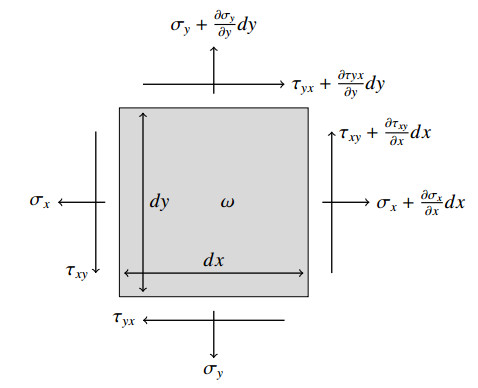









 DownLoad:
DownLoad:

